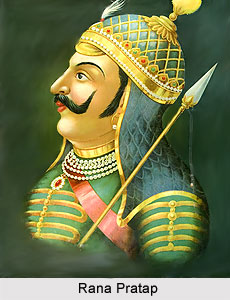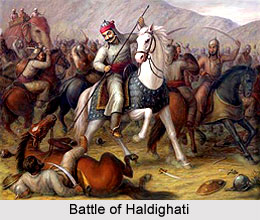 Haldighati Battle took place on June 18, 1576 between the imperial forces of Mughal emperor Akbar and Rajput king of Mewar Maharana Pratap Singh I. The battle only lasted for four hours and was an indecisive battle, which signified, an `inglorious success` for the Mughals and `a glorious defeat` for Mewar. But still the battle of Haldighati is remembered as the most memorable episodes in Rajput annals.
Haldighati Battle took place on June 18, 1576 between the imperial forces of Mughal emperor Akbar and Rajput king of Mewar Maharana Pratap Singh I. The battle only lasted for four hours and was an indecisive battle, which signified, an `inglorious success` for the Mughals and `a glorious defeat` for Mewar. But still the battle of Haldighati is remembered as the most memorable episodes in Rajput annals.
History of the Battle of Haldighati
History recounts that Haldighati battle was not fought in one day. By the mid of 15th century, Emperor Akbar had forced all Rajput kingdoms to become the part of his empire except Mewar. He could not make this leading Rajput force under his obedience. Akbar then changed his tactics. Throughout 1573, Akbar sent a series of emissaries to Rana Pratap with the proposal of peace treaty. Pratap singh agreed to sign the treaty but with the conditions of his own terms that he would not become submissive to any other rulers, particularly to any foreigner. And Mewar would not give up its independence. Akbar could not admit this rule. He was frustrated and humiliated and gathered the armies together and Mughal general Asaf Khan led the army. Rana Pratap`s enemy Raja Man Singh of Amber also took part in this mission to destroy Mewar. On May 3, 1576 the Mughals proceeded south towards the village of Haldighati, where in a pass Pratap singh was waiting for the Mughal army in his temporary capital of Kumbhalgarh.
How the Battle of Haldighati Took Place
On June 18, 1576 The Mughal army started to move. Before sunrise when the dawn broke, Bhil tribes saw the huge army of Mughal crossed the river and gathered near Khamnor. Pratap Singh moved his army at the neck of the Haldighati Pass. The Rajput Army halted and waited for the right moment to strike. Rana Pratap was a legendary warrior and his closest ally in many battlefields Chetak, his horse, took part in this battle with him.
 The horse was adorned with colorful and beautiful flexible armors that ended in a mask that resembled a fantastic elephant head. This was designed to terrify the enemy army and protect the horse from enemy`s war elephants with an assumption that elephants would think it as an elephant and would not harm another elephant.
The horse was adorned with colorful and beautiful flexible armors that ended in a mask that resembled a fantastic elephant head. This was designed to terrify the enemy army and protect the horse from enemy`s war elephants with an assumption that elephants would think it as an elephant and would not harm another elephant.
With the advent of the day, the Mughal army came even nearer. Ground trembled by the march past of the huge Mughal army and hence began a terrific battle, the Battle of Haldighati. Soon, a cloud of dust rose over the distant tree lines, covering the morning sun. Maharana Pratap led his army direct into a larger phalanx of troops under Qazi Khan. His war elephants covered the rear portion. An immediate panic spread among the Mughal army. As the youth group of Mewar started to attack with the arrows on the Mughal force, the fighters were waffled and then stumbled back across the rocky terrain.
Army Strength of Battle of Haldighati
For this battle, Man Singh has a command over 5000 strong army force. The Mughal armed forces were around 3000 cavalry, which was a huge and powerful number in front of Rana Pratap"s army strength. Akbar"s armed force was led by Man Singh. On the other hand, Bhills tribe, Rathores of Merta and Tanwars of Gwalior joined Rana Pratap to fight against the Mughals. Rana Pratap also had a small group of Afghan warriors, which was led by Commander Hakim Khan Sur.
Aftermath of the Battle of Haldighati
The Battle of Haldighati was a fierce battle. Man Singh joined the Mughals to defeat Rana Pratap, which was a proper sign of treachery. He even mistakenly killed Man Singh Jhala, one of Rana Pratap"s trusted men, thinking him to be Rana Pratap. Rana Pratap was also wounded ferociously on the battlefield. On the next day, when Man Singh again came to attack Mewar, then there was no one to defend the Mughals.
According to the historians, the result of this battle can be interpreted as indecisive or temporary victory for the Mughals. But it was a glorious defeat for Mewar, which showed their courage, valour and royalty towards their mother land. Along with the Rajputs, the Bhills tribe also showed courage and valour, which is seen as a great example of bravery.
Rana Pratap"s Repossession of Mewar Regions
The Battle of Haldighati was a turning point for the Mughals. After this battle, Rana Pratap kept on attacking Mughals in the aim of not letting them stay in peace in Mewar. They, hiding in the mountains, kept on doing enemy marched, poisoning the wells, looting, plundering and demolition of the Mughal camps. In the meantime, Rana Pratap got a strong financial support from Bhamashah and the Bhills tribe also helped them with their expertise to live in the forests. Akbar"s army was constantly getting failed to stop Rana Pratap and their army. In this way, Rana Pratap again captured the regions of Mewar from the Mughal rule, which he lost in the Battle of Haldighati. In 1597, Rana Pratap died in severe injuries so he made his son Amar Singh his successor.






































